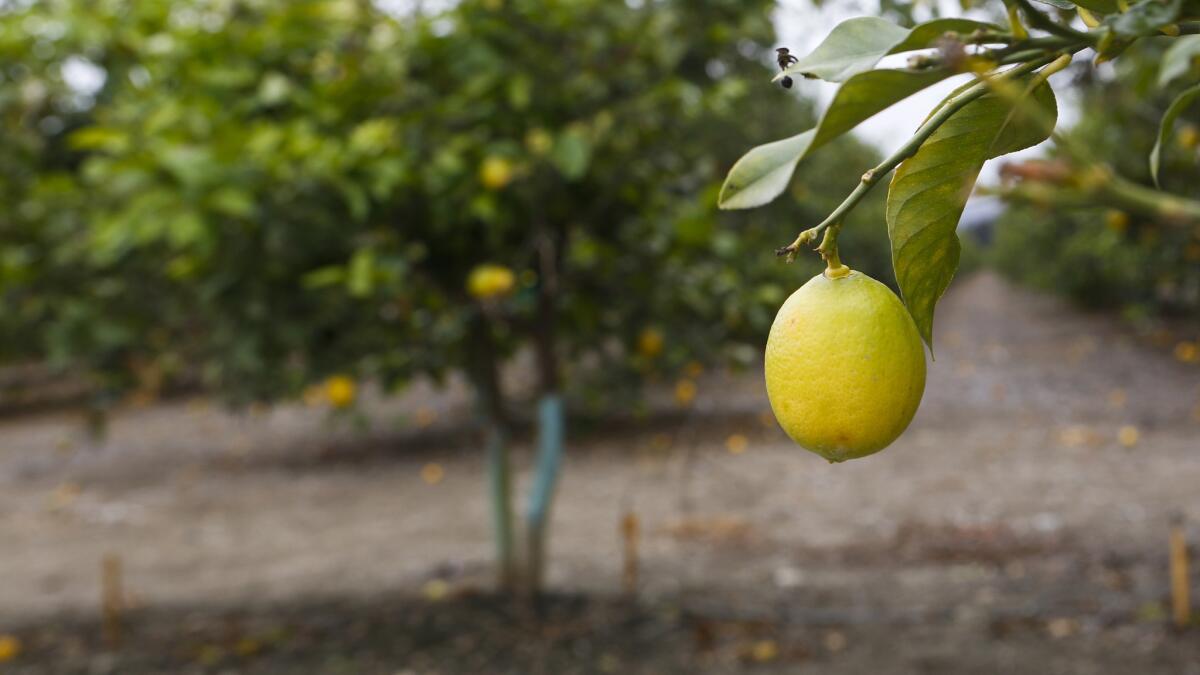Embarrassed officials try to explain surge in water use

Citrus trees grow a field in Ventura. The Casitas Municipal Water District, in Ventura County, reported a 26% increase in water use in May.
They stuck out like skunks at a drought-resistant garden party.
While residential water consumers and suppliers throughout California won praise for slashing water consumption 29% recently, a handful of small water agencies caused bewilderment when they reported a surge in water use in May.
In Kern County, California City reported a puzzling 28% increase in consumption, while the Casitas Municipal Water District, in Ventura County, appeared to have boosted water use 26%. Likewise, the San Gabriel Valley city of El Monte reported a 10% increase in water use, while the San Joaquin Valley city of Reedley reported a 9% jump.
GRAPHIC: Look up drought report cards for every water district
Conservationists wondered how this was possible.
Had they somehow missed Gov. Jerry Brown’s order to cut urban water use 25%? Did they overlook the many public information campaigns telling Californians to take shorter showers or to let their lawns fade to “gold” instead of watering them? Did they ignore the potential risk of fines from the State Water Resources Control Board?
Embarrassed officials this week offered a variety of explanations for their increased water use, each of which provided a glimpse into the challenges that small municipal water agencies face in trying to comply with the state’s first-ever mandatory water restrictions.
“It’s frustrating,” said Tom Weil, city manager of California City. “Hopefully the next time you see our numbers, there will be a difference.”
Weil attributed the 28% increase to several factors, including an expansion of the prisoner population at California City Correctional Center, which grew by almost a third last year. Similarly, he said it was only recently that the city had begun including water consumption at municipal facilities in its monthly reporting.
When cities and water agencies report their monthly water use, those figures are compared with the same month in the baseline year of 2013. Population increases that have occurred since then, or other changes, can skew the reporting, officials said.
But Weil added that an accounting error could have also come into play. He said it was possible that water transfers between holding tanks may have accidentally been counted as water consumption.
“We’re working with the state to try to correct the numbers,” Weil said.
At the Casitas Municipal Water District, which reported a 26% increase, officials said a dispute with the state water board about the reporting of agricultural water had obscured progress on residential conservation.
Although the governor’s order applies to urban areas, and not agriculture, 45% of the district’s water goes to citrus and avocado growers. But the water board has ordered the agency to include agricultural water use in its monthly reporting, said Ron Merckling, public affairs resource manager for the district.
“It’s disheartening,” Merckling said. “We were essentially created as a backup water source for droughts. When the groundwater levels deplete, agricultural customers tend to rely on us a lot more, so water usage goes up.”
Merckling said that when agricultural water use was removed from the equation, residential water use showed a drop of roughly 20%.
“We’re making a lot of the conservation efforts that many other agencies are doing, and we’re seeing results,” Merckling said.
In El Monte, Mayor Andre Quintero said he was surprised and disappointed to learn that the city’s water department had a 10% increase in use — especially because the privately owned San Gabriel Valley Water Co., which supplies water to his home and other areas of the city, reported a 35% reduction.
He said the city is revamping its water department, but that it was a challenge. A “dilapidated” and faulty metering system was in the process of being replaced, while the city was searching for an executive director for the department.
“This is a public water agency that has historically been neglected,” Quintero said. “We need someone who can really focus in on our water department and make sure we’re doing all the things we’re supposed to be doing. … We haven’t gotten there yet.”
El Monte Public Works Director Frank Senteno said that new construction in the city was also a likely factor in the increase. He said he hoped that the passing of proposed lawn watering restrictions and other conservation measures that are scheduled to go before the City Council next week would improve the situation.
“Hopefully we’ll be able to see a reduction in the months following,” Senteno said.
In the city of Reedley, in Fresno County, officials said their 9% increase was likely due to belated conservation efforts.
Russ Robertson, the public works director, said a city ordinance restricting outdoor watering to two days a week, as well as other conservation measures, hadn’t taken effect until the end of May.
He said the city, along with Clovis and Fresno, had also just received a grant to fund a lawn rebate program for up to $1,000 per household.
“I’m disappointed, to tell you the truth,” Robertson said. “But … we’re already seeing the numbers trend downward, and we’re very hopeful we’ll decrease our water usage rather than the continue on the trend of increasing.”
Twitter: @montemorin
Twitter: @taygoldenstein
MORE DROUGHT NEWS:
Lake Mead hits a new low, but the drought has a silver lining - tourism
Drought puts California pool repairman who works underwater in high demand
Drought drives greater household use of gray water
More to Read
Sign up for Essential California
The most important California stories and recommendations in your inbox every morning.
You may occasionally receive promotional content from the Los Angeles Times.












